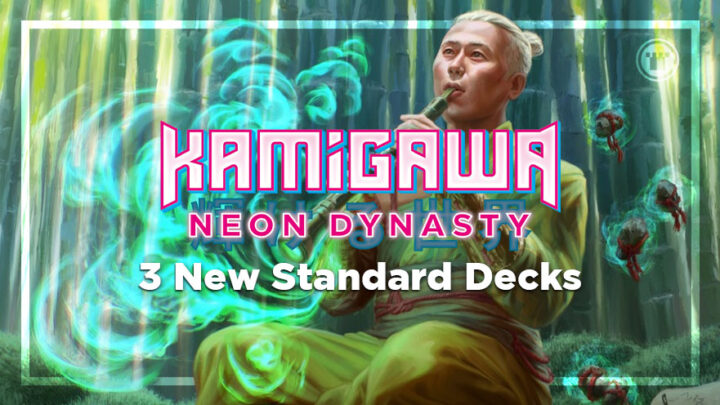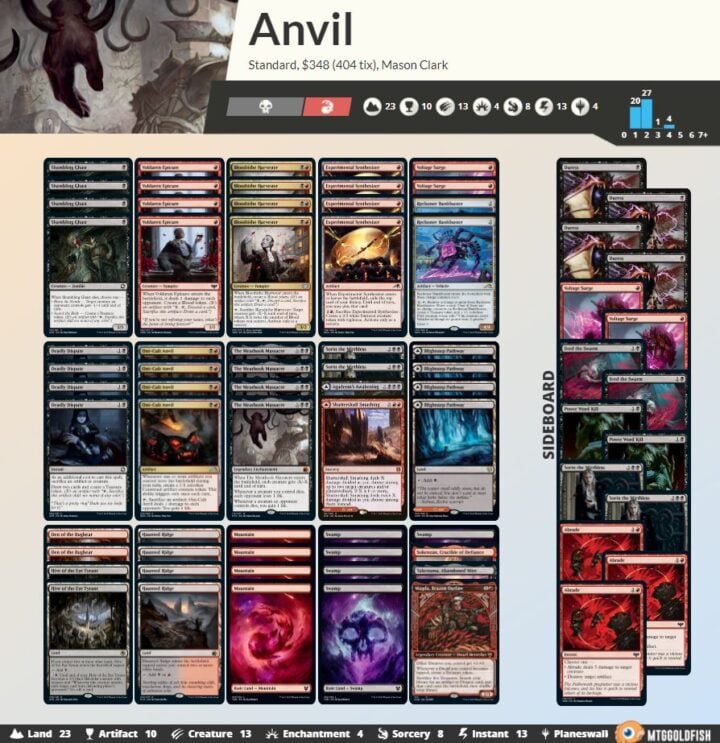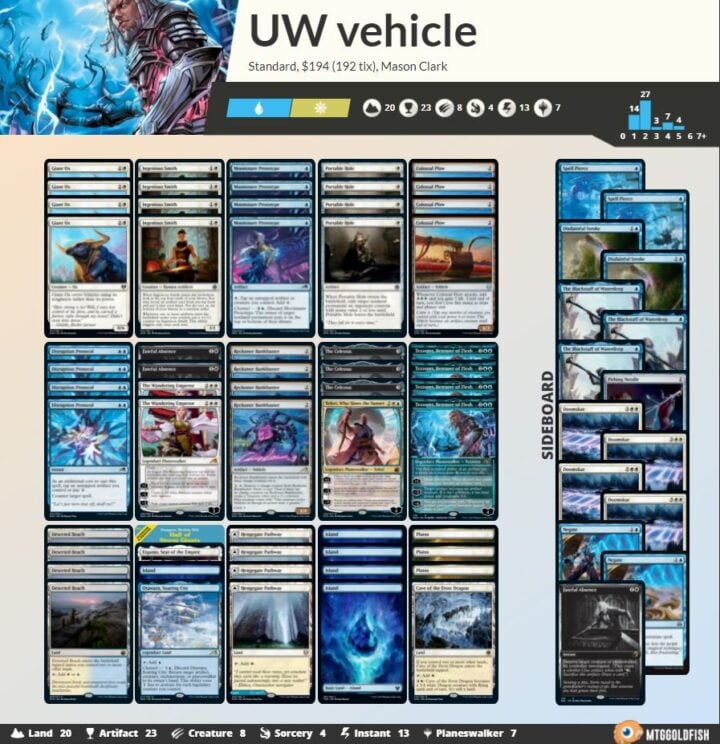Kamigawa: Neon Dynasty has been out on MTG Arena for a week now, which has given players plenty of time to explore the new set. Despite needing to play Limited for some events coming up, the siren song of this set was too much for me to resist. After playing way more Standard then I had planned, I’ve found a handful of new decks that I’ve loved, all featuring powerful, high-synergy cards from this set.
Today, I’d like to share some of those decks with you. These decks have been some of my favorites that I’ve played in the last year, and they’re also serious contenders if Standard continues on its current trajectory.
Oni-Cult Anvil
If you’re an old fogey like me, you remember Hidden Stockpile from Aether Revolt. This deck operates in the same vein, using Oni-Cult Anvil as its main engine. Your goal is to win the war of attrition by accruing incremental advantages, mainly through sacrificing artifacts like Treasures and Blood tokens.
Oni-Cult Anvil is the star of the deck, but the deck is more than capable of winning without it. For one thing, the deck has an incredible amount of card draw. Experimental Synthesizer has been a breakout star in this build – it works well with Anvil and Deadly Dispute by generating value when it enters and leaves the battlefield, and it doubles as a way to clog up the board. Synthesizer allows you to start your turn three by leading on it and maybe finding a land drop or a spell to play.
That leads me to this deck’s second strength: it has an incredibly low curve. Aside from Sorin the Mirthless, all your spells cost two mana or less. It’s easy to cast two or three spells on crucial turns, and to maximize cards like Synthesizer and Sorin. This is also why Deadly Dispute is so strong in this deck – it’s often very easy to blank a piece of interaction or chump and draw some cards, then throw three spells down the next turn. And the more creatures you can play, the easier it will be to drain your opponents’ life totals with The Meathook Massacre.
The last card I’d like to highlight in this deck is Reckoner Bankbuster – a card that I’m already a huge fan of. Depending on the situation, it functions like a Mazemind Tome or a Heart of Kiran, both of which were incredibly powerful in their respective Standard metagames. And while Bankbuster isn’t quite as strong as either card, it excels at pressuring opposing players and walkers, while also being a way to keep the cards flowing when you hit a land patch. You also get the bonus of being able to beat down some percentage of the time in the early turns, which will allow you to keep more controlling decks honest.
Oni-Cult Anvil is a well-rounded deck with several angles of attack. It’s my favorite deck that I’ve played in Standard in a very long time, bar none.
UW Vehicles
One of the cards that has impressed me the most in the last week is Tezzeret, Betrayer of Flesh. The ability to filter through cards has been pivotal in the midgame, which is one of the most critical points in a game of Standard. His -2 ability has also been instrumental in starting to close the game out. So, when I was putting together decks for this article, I wanted to be sure to mention one that could take full advantage of Tezzeret.
This deck has one of the more unique game plans in Standard: run your opponent out of resources, and use your Vehicles to cross the finish line. It’s essentially a low-to-the-ground midrange deck, which isn’t normally my speed, but like I said, this deck is a little different.
For starters, it’s hard to be a big midrange deck with clunky spells. Alrund’s Epiphany and Divide By Zero might be gone, but Goldspan Dragon is still a very effective tool for closing games out quickly. Having the ability to play a Colossal Plow on turn two, attack on three, and get a huge burst of mana is very appealing. While I might see this deck eventually dropping the Plow and Giant Ox as the metagame evolves, I’ve been pleasantly surprised by this deck so far. The Ox is also a good roadblock against Mono-Green Aggro, so it can play both offense and defense effectively.
Another key card in this deck is Moonsnare Prototype, the newest Springleaf Drum variant. Prototype does a great job of helping you get out ahead of your opponents early, but in the late game, you can use the channel ability as a form of soft removal. So if your opponents have built up a big creature, or they have a late-game walker about to ult, Prototype will answer it. If you’ve played Hammer Time in Modern, you know how soul crushing it is to draw Springleaf Drum late, so the channel ability is a huge upgrade.
The last card that drew me into this deck is Disruption Protocol. A new Cancel isn’t particularly exciting, but this one has a useful cost reduction clause (you can tap an artifact instead of paying the one colorless mana). It’s very powerful with the Portable Holes and Moonsnare Prototypes we’ll be playing in the early turns. Disruption Protocol also lets you play to the board in the midgame while preventing big cards like Goldspan Dragon from coming down. It’s the secret sauce that makes this whole deck come together – cheap interaction and permission go a long way, especially when your opponents are getting run over by artifacts.
GW Enchantments
Like the other lists we talked about today, we’re leaning heavily on some synergies here. Except instead of harnessing the artifacts of Kamigawa’s present, we’re leaning into the enchantments that represent its past.
This deck is looking to make the most of the new Standard and Pioneer all-star, Michiko’s Reign of Truth. It’s the kind of enchantment payoff these sort of decks need – it doesn’t go all-in like an All That Glitters, and allows several creatures to become threats over multiple turns. That sort of flexibility in pushing damage is very hard for some decks to answer.
Meanwhile, Generous Visitor is the one-drop that enchantment decks have been wanting for years. Not only does it allow you to go all-in on one creature, but it doubles as a lighting rod early. With Visitor, the deck has the potential to run people over or spread the power out, so by the time it dies, your other creatures will have grown out of hand. Enchantment decks have desperately needed an effect like this, as they’re typically trying to build one or two really big creatures.
Going all-in on a single creature, as enchantment decks typically do, can be a liability. But that’s where Kami of Transience comes in. The card builds itself up, so we don’t have to commit as many resources to turn it into a threat, and when it eventually does get answered, you can easily bring it back. While rebuilding does take time, it’s better than not having the option at all, which is all too common in all-in enchantment decks.
Ultimately, this deck is looking to build critical mass, but it does so in a unique and resilient way. Throw in a powerful late game threat like Hallowed Haunting, and this might be the first playable enchantment-themed deck in Standard since Abzan Constellation.
Those are all the new decks I have for you today. What have you been playing in Standard this week? Tweet at @masoneclark and let me know!

Mason Clark is a grinder in every corner of the game who has played at the pro level and on the SCG Tour with Team Nova. Whether he’s competing in Standard, Historic or Modern, Mason plays with one goal in mind: to be a better player than he was the day before. Check out his podcast, Constructed Criticism, and catch his streams on Twitch.




